Our Terms & Conditions | Our Privacy Policy
Scientists find strongest evidence of life on distant planet K2-18b


Scientists have discovered the strongest evidence yet of potential life on planet K2-18b, signaling a possible breakthrough in extraterrestrial research.
Scientists using the James Webb Space Telescope have discovered promising signs that life could potentially exist on a distant planet named K2-18b. Located 124 light-years away, the planet’s atmosphere contains molecules such as dimethyl sulfide (DMS) and dimethyl disulfide (DMDS), which are only produced by living organisms on Earth.
The James Webb Telescope identified these molecules by analyzing starlight passing through K2-18b’s atmosphere. K2-18b is a planet 2.6 times larger in diameter and 8.6 times more massive than Earth, orbiting a red dwarf star. The discovery adds to previous observations by the Hubble Telescope, which identified water vapor in the planet’s atmosphere.
James Webb’s latest findings indicate the presence of methane, carbon dioxide, and possibly vast oceans on K2-18b, creating conditions that could be suitable for life. The planet is classified as a “Hycean” world, characterized by expansive oceans and a hydrogen-rich atmosphere, potentially an ideal environment for life.
K2-18b was discovered by the Kepler Space Telescope in 2015, and its unique features have drawn significant attention since then. While Webb’s observations suggest the planet’s temperature may allow liquid water, its red dwarf star could present challenges due to harmful radiation that could hinder the development of life.
This discovery has sparked significant excitement regarding the potential for extraterrestrial life. However, scientists remain cautious. Dr. Megan Mansfield of the University of Arizona emphasized that while the findings are strong, they do not offer conclusive proof of life. Further research is needed to determine whether non-biological chemical processes could account for the molecules observed.
while the detection of these molecules raises the possibility of life on K2-18b, scientists continue to carefully analyze the data. Future observations by the James Webb Space Telescope will provide more accurate insights, which could ultimately shape our understanding of life beyond Earth.
[ad_1]
Images are for reference only.Images and contents gathered automatic from google or 3rd party sources.All rights on the images and contents are with their legal original owners.
[ad_2]



Comments are closed.